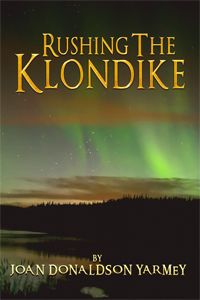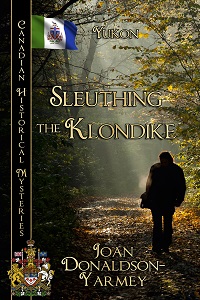https://books2read.com/Sleuthing-the-Klondike
https://books2read.com/Rushing-the-Klondike
https://books2read.com/Romancing-the-Klondike
BWL Publishing Inc. published twelve books of the Canadian Historical Brides Collection in 2017, Canada's 150th birthday. Each book was set in one of the ten provinces or two territories (Northwest Territories and Nunavut were combined). Because I had travelled to the Yukon twice and had hiked the Chilkoot Trail on the hundredth anniversary of the Klondike Gold Rush in 1997, I chose the Yukon of 1896/97 to write about. My novel, Romancing the Klondike, was published as a hard copy and ebook in 2017 with an audible version being released in 2022. It follows the lives of two young women who travel from Halifax to Fortymile on the Yukon River in 1896.
Pearl Owens is commissioned to write articles about the north for her hometown newspaper. She is accompanied by her cousin, Emma, and they plan on meeting up with Emma’s brother who has been in the north with two friends for five years. Gold is discovered on Rabbit Creek just as they arrive. Emma marries one of Sam’s friends and returns to Halifax while Pearl remains in the newly established Dawson.
I wrote a sequel to that book, Rushing the Klondike which was published in October of 2022. Although it is not part of the Canadian Historical Brides Collection, it is a continuation of the original Romancing the Klondike story.
This year BWL, Inc has begun releasing the Canadian Historical Mysteries Collection, which includes twelve mystery novels set in each of the Canadian provinces and territories. My novel, Sleuthing the Klondike, was published in April, 2023 and also takes place in the summer of 1898. Helen Castrel arrives in Victoria, B.C after a long journey from London, England and hires Detective Baxter Davenport to go with her to Dawson City to find her brother. David Castrel is a remittance man who hasn’t been heard from for a year. While the main characters are different from my other two books, their lives become intertwined with the characters of the first Klondike books during their investigation.
The following is a brief history of the Yukon
The name Yukon is derived from the Loucheux
first nations word Yukunah which means `big river'. The land was mainly
occupied by the Tagish and Tlingit native people for centuries before the
non-native explorers arrived in the 1820s. In the 1840s fur traders set up a
few Hudson's Bay Company posts along the Yukon River. When the United States
purchased Alaska from Russia in 1867, there wasn’t a clear border between
Alaska and the Northwest Territories, as the land was known then. In 1887-88
William Ogilvie, a Canadian surveyor, surveyed the area making the 141st
meridian the western boundary with Alaska and the 60th parallel the
southern border with British Columbia. Hence the phrase North of 60.
Prospectors
went north looking for gold in the 1880s and there was a gold strike along the
Fortymile River, which drains into the Yukon River, in 1886. There were other
smaller strikes until 1896 when gold was discovered on Rabbit Creek later
renamed Bonanza Creek. A town named Dawson sprang up on the Yukon River at the
mouth of the Klondike River. When word of the gold discovery reached the
outside world in the summer of 1897, thousands of men, women and children hurried
to Dawson during the winter of 1897-1898 hoping to find their fortune.
Because
of the rush Dawson grew quickly to be the largest city north of San Francisco
and it became known as the `Paris of the North'. It had hotels, dance halls,
daily newspapers and saloons for its 30,000 inhabitants. Fresh eggs were
brought by raft on the Yukon River; whiskey came in by the boatload before
freeze-up; gambling made rich men out of some and paupers out of others; dance
hall girls charged $5 dollars in gold for each minute they danced with a miner;
the janitors made up to $50 dollars a night when they panned out the sawdust
from the barroom floors. Due to the influx of people, the region officially
entered into the confederation of Canada and was designated as the Yukon
Territory on June 13, 1898. Dawson became the capital. Eventually the word
`territory' was dropped and it was called The Yukon.
A Territorial Administration Building was constructed in 1901 for the
territorial seat of government and Dawson was the centre for the government
administration until 1953 when the capital was moved to Whitehorse.
The Klondike gold rush ended in 1899 when word of a gold discovery in
Nome, Alaska, reached the prospectors and they headed further north. However,
over the next few decades gold companies were formed and continued to mine the
creeks, this time using dredges to dig up the creek bottom. They left behind
huge piles of gravel called tailings. The dredging lasted until 1960 when gold
prices declined making the operation uneconomical. Today, mining is done with
big trucks, huge sluices, and back hoes.
The north is known as the Land of the
Midnight Sun after the words in Robert W. Service’s poem The Cremation of Sam McGee:
There are strange things done in the midnight
sun
By the men who moil for gold.
The Arctic Circle is the most northerly of the five major circles of latitude of the Earth.
It is an imaginary line that marks the southern edge of
the Arctic at 66 degrees 30' north latitude in the Yukon and Northwest
Territories of Canada, and in Alaska, Scandinavia and Russia. The land north of
the Arctic Circle gets 24 hours of sunlight on the longest day of the year,
June 21st. The further north of the circle you go the more days of total
sunlight in the summer you will get. This is because the North Pole is tilted
towards the sun and gets direct sunlight from March 20 to September 22 as the
earth rotates. Conversely, on the shortest day, December 21st, the land north
of the Arctic Circle gets 24 hours of darkness because the North Pole is tilted
away from the sun.
The Yukon is a great place to view the
aurora borealis or northern lights. These are bright dancing lights that are really collisions
between the gaseous particles of the Earth’s atmosphere and the electrically
charged particles from the sun that enter the earth’s atmosphere. The most
common colours are pink and pale green produced by oxygen molecules about sixty
miles above the earth. Silver, blue, green,
yellow and violet also appear in the display. Red auroras are rare and produced
at high altitudes of about 200 miles. The lights are
best seen in the winter and the further north you are the better they appear.
The Yukon has the smallest desert in the
world, the Carcross Desert, near the town of Carcross. It is an area that was
once covered by a glacial lake. As the glaciers melted the level of the lake
lowered until just the sandy bottom was left. Winds off Lake Bennett keep the
sand moving and prevent most plants and trees from taking root on this.
During the late Wisconsin ice age (10,000
to 70,000 years ago) an arid section of the northern hemisphere was not
glaciated because of the lack of moisture to support the expansion of the
glaciers. The area, called Beringia after the Bering Strait which is near the
centre of the region, encompassed parts of present-day eastern Siberia, Alaska,
The Yukon, and ended at the Mackenzie River in the Northwest Territories. The
growth of continental glaciers sucked up moisture which led to the sea level
dropping by up to 106 metres (350 feet). As a result, a land bridge was formed
between northwest North America and northeast Asia.
It is believed that parts of western
Beringia (eastern Siberia today) were occupied by man 35,000 years ago. The
forming of the Bering Land Bridge allowed the first humans to travel from Asia
to North America. There is evidence that the history of man in North America
goes back 25,000 years ago.
Some of the animals that survived for
thousands of years in this arid land surrounded by glaciers were the North
American horse and camel, the steppe bison, the giant beaver that weighed up to
181 kilograms (400 pounds), the Mastodon, the woolly mammoth, the giant short-faced
bear, the scimitar cat, the American lion, and the giant ground sloth. All of
these are extinct.
The territory of The Yukon was founded on
gold mining, but there has been coal and silver mining in the territory also. It
is now a favourite destination for tourists.






.jpg)
.jpg)
.jpg)





.jpg)



















